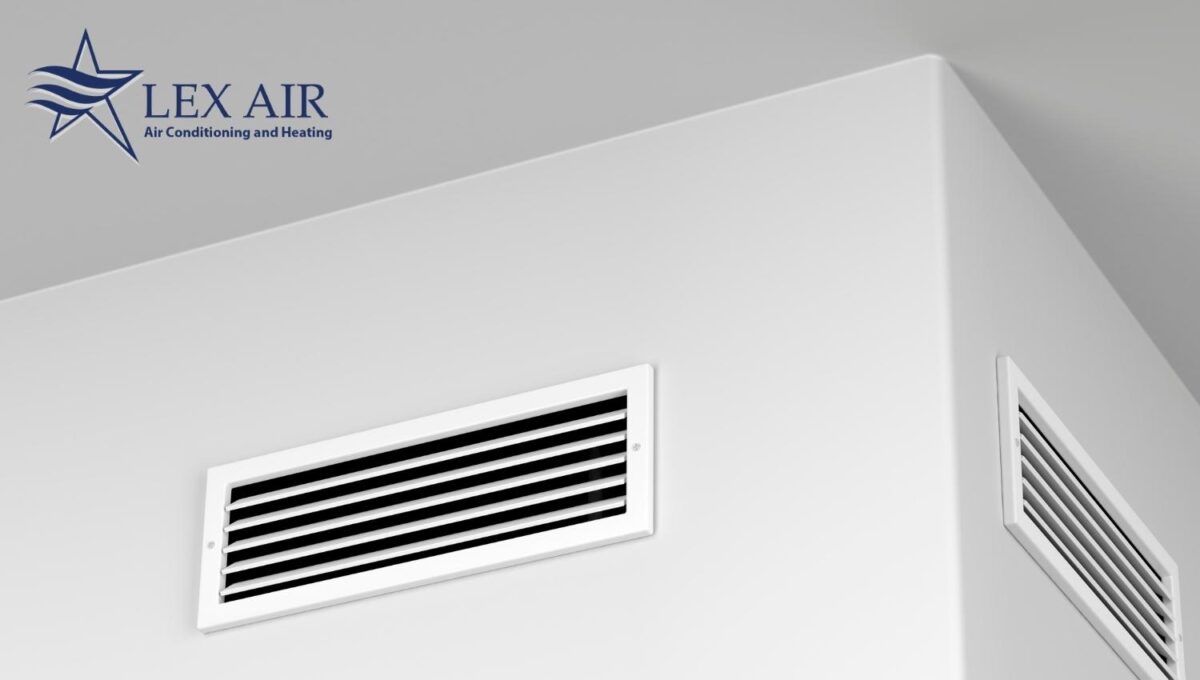Have you ever looked at your digital thermostat and seen the words “Aux Heat” on the screen? Aux heat refers to your heating system’s auxiliary heat, which is used to help quickly raise the temperature in your home to the set thermostat temperature.
But what exactly is aux heat, and how does it work? Is the aux heat setting bad? In this article, our Carrollton heating and air conditioning pros teach you everything you need to know about auxiliary heat and how to ensure your heat pump and aux heat are working properly.
If you’re experiencing issues with your heater or your aux heat system, the heating experts at Lex Air Conditioning & Heating are here for you. We can provide you with an accurate diagnosis of the problem as well as repair the issue so you can once again enjoy the comfort of your own home. Call us at (972) 217-8955 to learn more about what we can do for you.
What is Auxiliary Heat?
Before we can understand whether or not aux heat is a bad thing, we should first answer the question “What is auxiliary heat?” Auxiliary heat, often referred to as “emergency” or “backup” heat, is a supplemental heating source that is integrated into most heat pump systems. While most heat pumps can handle the brunt of the work when it comes to heating your home, there are times when the outdoor temperatures drop so low that the heat pump can’t efficiently warm your home.
This is where auxiliary heat comes in. It provides an additional boost of warmth, ensuring that your home remains at the desired temperature, especially in particularly cold conditions. It’s designed to work in tandem with the heat pump, providing comfort and efficiency to your heating system.
Auxiliary heat isn’t a bad thing; in fact, it can be extremely necessary to your comfort and well-being, especially in the event of extreme cold weather. However, auxiliary heat uses a good deal of energy, which leads to an increase in your energy bill. That’s why it’s important to ensure that your system isn’t switching to aux heat unnecessarily.
How Do Heat Pumps Work?
Your home’s central heating system, or heat pump, actually serves two purposes: it can keep your home warm in the winter, and it can keep your home cool in the summer (and in the spring and in the fall, for that matter).
Your heat pump is able to transfer heat into your home by pulling heat energy from the outside and pulling it into your home. It’s even able to pull heat from cold air! If the air is too cold, however, it needs to rely on a supplemental heat source: the system’s auxiliary heat.
How Does Auxiliary Heat Work?
When your heat pump can’t generate enough hot air, it uses electric resistance heating strips, which, when given enough electricity, can generate a good deal of heat.
If your thermostat is set to “heat” and the temperature inside your home is a few degrees below the temperature that the thermostat is set to, the words “aux heat” may pop up on the thermostat. When that happens, the thermostat energizes auxiliary heat strips within your HVAC system and uses the heat generated from them to act as a supplemental heat source for your heat pump.
Heat pumps tend not to work very quickly, so the auxiliary heat strip inside your system simply gives your heat pump the boost it needs to actually produce enough heat.

Why Might Aux Heat Turn On?
There are a few reasons why your system is triggering an auxiliary heat cycle. Below are some examples of situations where your home’s auxiliary heat may be activated.
Increased Temperatures on Thermostat
When you drastically increase the temperature on your thermostat in the winter, the system recognizes the need for a rapid temperature boost.
Since your heat pump can’t produce enough heat to reach that temperature in a reasonable amount of time, it will automatically switch on auxiliary heat mode. The auxiliary heat will be able to quickly raise the indoor temperature to the set temperature, providing supplemental warmth alongside the heat pump.
Defrost Cycle
If the outdoor unit gets too cold, the outdoor coils can freeze, making it impossible for your heat pump to draw heat energy in from the outside. That’s why heat pumps have a defrost mode, which will–you guessed it–remove frost from the outdoor coils.
During this cycle, the system is effectively in cooling mode, which could cool the indoor air. To prevent this, the aux heat activates, ensuring that your indoor environment remains warm and cozy, even while it’s freezing outside.
Extremely Cold Weather
Heat pumps are designed to extract heat from the outdoor air and bring it indoors. However, as the outdoor temperature drops, the heat pump’s efficiency drops as well. If it’s particularly chilly, the aux heat mode might turn on to support the heat pump and keep your home warm.
Emergency Heat is On
If you switch your thermostat setting to “Emergency Heat,” you’re manually activating the auxiliary heat. This bypasses the heat pump entirely, relying solely on the auxiliary system.
The emergency heat mode is a useful function when your heat pump is experiencing issues or if you’re in the process of undergoing maintenance, but otherwise, you likely won’t need to use the emergency heating setting.
System Malfunction
Sometimes, the auxiliary heat might activate due to a malfunction within the heat pump system. This can occur due to a faulty sensor, a thermostat miscommunication, or a separate mechanical issue, which can cause the system to mistakenly believe it needs the help of the auxiliary heat. If this is the case, consult with a Murphy HVAC professional at Lex Air who can diagnose and fix the problem for you.

How Do I Stop My Auxiliary Heat from Coming On?
Many people have to toe the line between keeping their homes comfortable and keeping their energy costs low, which is why many homeowners want to stop auxiliary heat from coming on at all. One of the best ways to prevent your system’s aux heat from coming on is by only adjusting your thermostat’s set temperature by a degree or two at a time.
Usually, if the set temperature is three or more degrees above the current indoor temperature, it automatically switches the aux heat on. Increase the set temperature by a degree and wait for the room to warm up, then increase the temperature by another degree or two. Repeat until you’ve set the thermostat to the desired temperature.
If your heat pump is efficient enough, you may be able to avoid using auxiliary heating altogether. The best way to ensure your system is as efficient as possible, for as long as possible, is by scheduling regular heat pump maintenance.
Routine Heat Pump Maintenance
Regular heating maintenance is essential to ensuring your system lives a long and energy-efficient life. Just like any other mechanical system, your heat pump can greatly benefit from periodic checks and tune-ups.
We at Lex Air provide our customers with expert heating tune-ups in Carrollton to ensure your system is working exactly as it should be. When you hire our heater maintenance services, we’ll inspect your system’s electrical components and connections, check your refrigerant levels, and ensure your system’s controls are working properly.
Tune-ups are much more effective at extending the life of your system and ensuring its efficiency if they’re done annually. By sticking to a routine maintenance schedule, you can prevent minor issues from turning into costly repairs, reduce your system’s energy consumption, and ensure a comfortable indoor environment year-round.
That’s why we provide a yearly HVAC maintenance plan to Carrollton residents and those in the greater Dallas area. We can help ensure you have an energy-efficient heat pump that will provide you with enough heat all winter long, and ensure your air conditioning system is prepared to beat the heat when the time comes. Call us today at (972) 217-8955 to learn more about what we can do for you and your home.

Signs Your Auxiliary Heating System is Malfunctioning
While it can be difficult to tell whether or not your HVAC system is malfunctioning, there are a few telltale signs that could indicate your auxiliary equipment isn’t working properly. Below are some of the most common indicators that may tell you your aux heat system needs repairs.
In any case, if you’re having trouble with your heat pump or auxiliary heating system, calling a Carrollton HVAC company is likely your best option. By detecting and resolving heating problems early, you can prevent yourself from dealing with more significant, costly repairs down the line.
Aux Heat Doesn’t Respond to Thermostat Changes
One of the easiest ways to spot an aux heat malfunction is to watch what your thermostat does when you change the set indoor temperature. If you have your heater on, and you set the temperature to a temperature below the room’s temperature, the aux heat should automatically switch off.
The same goes for the inverse scenario: if you set the temperature to something a few degrees above the room temperature, the aux heat should automatically switch on. If it doesn’t respond to either of these changes, your auxiliary heat may be malfunctioning or broken.
Aux Heat Runs Constantly
If your thermostat displays the “Aux Heat” or “Emergency Heat” indicator for extended periods, even in mild weather, your system may not be switching between primary and auxiliary modes correctly.
Defrost Mode is Always On
Your system may be using an excessive amount of energy if your heat pump is in defrost mode for extended periods of time. This could be due to ice on your outdoor unit, but it could also be due to a system error or a broken sensor. A Heath HVAC technician from our team will be able to diagnose and repair the problem for you to ensure your system doesn’t waste electricity using aux heat when it doesn’t need to.
Unexplained Increase in Energy Costs
Another tell-tale sign that your heating system is using aux heat is by checking your monthly energy bill. The electric resistance heating strips in your system require a lot of energy, so if your electricity bill is much higher than it should be, your heat pump may be using aux heat unnecessarily, possibly due to a system glitch.
How to Fix Aux Heat on Thermostat
If the problem is minor, you may be able to address your system’s auxiliary heat issues directly. First, switch your system to its regular heat setting, not its “emergency heat” setting. Emergency heat relies solely on the auxiliary heat and completely bypasses the heat pump. Your system may switch to auxiliary heat for a short period of time to reach the desired temperature, but it should switch off after the temperature inside your home rises a bit.
If you have a programmable thermostat, make sure that the settings and schedules are correctly configured. Inconsistencies or excessively high temperature settings may cause your system to rely on aux heat more than it should.
You can perform a soft reset by turning off the thermostat and waiting a few minutes before turning it back on, which may help solve minor technical glitches. Your thermostat may also malfunction if its batteries are low, so check and see if your thermostat needs new batteries.
If these steps don’t resolve the issue and your system’s aux heat indicator remains active, you should call a Mansfield HVAC professional and have them diagnose the issue. They’ll be able to find the problem and solve it for you, ensuring your heat pump begins functioning as normal. Looking for a reliable HVAC company in the Carrollton area? Look no further–we at Lex Air are ready to help.

Issues With Your Heating System? Call the Professionals at Lex Air Conditioning and Heating
Even if it doesn’t see much use throughout the majority of the year, your heat pump is one of the most essential parts of your home. It’s in charge of ensuring you and your family are warm and comfortable, even in extreme weather conditions. If your heat pump can’t provide you with that warmth on its own, it uses the auxiliary heating system as a secondary heating source to heat your home quickly.
When one or both of these components aren’t working properly, you and your family could be stuck without sufficient heating, which can be dangerous if the outside temperature is extremely low.
It’s important to have a local HVAC company that is committed to providing you with excellent service and expert repairs, all at a competitive price. Lex Air is here to help you and your family stay comfortable all year round, and we can provide you with heat pump and auxiliary heat repairs when you need them the most.
We won’t leave you out in the cold–call Lex Air today at (972) 217-8955 or contact us online to schedule our high-quality HVAC services today.












